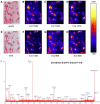MALDI-mass spectrometry imaging identifies vitronectin as a common constituent of amyloid deposits
- PMID: 26101327
- PMCID: PMC4823803
- DOI: 10.1369/0022155415595264
MALDI-mass spectrometry imaging identifies vitronectin as a common constituent of amyloid deposits
Abstract
Amyloids are pathological intra- and extracellular fibrillar aggregates of polypeptides with a cross-β-sheet structure and characteristic tinctorial properties. The amyloid deposits commonly enclose several non-fibrillar components of the extracellular matrix. Their potential to regulate the formation and aggregation process of amyloid fibrils is still poorly understood. For a better understanding of the role of the extracellular matrix in amyloidosis, it is essential to gain deeper insights into the composition of amyloid deposits. Here, we utilized matrix-assisted laser desorption and ionization mass spectrometry imaging to identify extracellular matrix compounds in amyloid deposits. Using this technique, we identified and determined the spatial distribution of vitronectin within AApoAI-, ALλ-, ATTR- and AIns amyloid deposits and, using immunohistochemistry, validated the spatial overlap of vitronectin with amyloids in 175 cases with diverse types of amyloid in several different tissues.
Keywords: amyloid; formalin-fixed/paraffin-embedded tissue; immunohistochemistry; mass spectrometry imaging; matrix-assisted laser desorption/ionization; vitronectin.
© The Author(s) 2015.
Conflict of interest statement
Figures


Similar articles
-
[Amyloid Registry Kiel : An interim balance].Pathologe. 2018 Dec;39(Suppl 2):301-305. doi: 10.1007/s00292-018-0515-x. Pathologe. 2018. PMID: 30302563 Review. German.
-
Imaging mass spectrometry analysis of renal amyloidosis biopsies reveals protein co-localization with amyloid deposits.Anal Bioanal Chem. 2015 Jul;407(18):5323-31. doi: 10.1007/s00216-015-8689-z. Epub 2015 May 3. Anal Bioanal Chem. 2015. PMID: 25935672
-
MALDI Mass Spectrometry Imaging: A Novel Tool for the Identification and Classification of Amyloidosis.Proteomics. 2017 Nov;17(22):1700236. doi: 10.1002/pmic.201700236. Proteomics. 2017. PMID: 28994248 Free PMC article.
-
MALDI mass spectrometry imaging unravels organ and amyloid-type specific peptide signatures in pulmonary and gastrointestinal amyloidosis.Proteomics Clin Appl. 2021 Nov;15(6):e2000079. doi: 10.1002/prca.202000079. Epub 2021 Jun 12. Proteomics Clin Appl. 2021. PMID: 34061454
-
MALDI IMS and Cancer Tissue Microarrays.Adv Cancer Res. 2017;134:173-200. doi: 10.1016/bs.acr.2016.11.007. Epub 2017 Jan 12. Adv Cancer Res. 2017. PMID: 28110650 Review.
Cited by
-
Bringing Matrix-Assisted Laser Desorption/Ionization Mass Spectrometry Imaging to the Clinics.Clin Lab Med. 2021 Jun;41(2):309-324. doi: 10.1016/j.cll.2021.03.009. Clin Lab Med. 2021. PMID: 34020766 Free PMC article. Review.
-
Amyloidosis: What does pathology offer? The evolving field of tissue biopsy.Front Cardiovasc Med. 2022 Dec 5;9:1081098. doi: 10.3389/fcvm.2022.1081098. eCollection 2022. Front Cardiovasc Med. 2022. PMID: 36545023 Free PMC article. Review.
-
Effect of dynamic exclusion and the use of FAIMS, DIA and MALDI-mass spectrometry imaging with ion mobility on amyloid protein identification.Clin Proteomics. 2024 Jul 3;21(1):47. doi: 10.1186/s12014-024-09500-w. Clin Proteomics. 2024. PMID: 38961380 Free PMC article.
-
Proteomic Evidence for Amyloidogenic Cross-Seeding in Fibrinaloid Microclots.Int J Mol Sci. 2024 Oct 8;25(19):10809. doi: 10.3390/ijms251910809. Int J Mol Sci. 2024. PMID: 39409138 Free PMC article.
-
[Amyloid Registry Kiel : An interim balance].Pathologe. 2018 Dec;39(Suppl 2):301-305. doi: 10.1007/s00292-018-0515-x. Pathologe. 2018. PMID: 30302563 Review. German.
References
-
- Akiyama H, Kawamata T, Dedhar S, McGeer PL. (1991). Immunohistochemical localization of vitronectin, its receptor and beta-3 integrin in Alzheimer brain tissue. J Neuroimmunol 32:19-28. - PubMed
-
- Anderson DH, Hageman GS, Mullins RF, Neitz M, Neitz J, Ozaki S, Preissner KT, Johnson LV. (1999). Vitronectin gene expression in the adult human retina. Invest Ophthamol Vis Sci 40:3305-3315. - PubMed
-
- Basara ML, McCarthy JB, Barnes DW, Furcht LT. (1985). Stimulation of haptotaxis and migration of tumor cells by serum spreading factor. Cancer Res 45:2487-2494. - PubMed
-
- Bronfman FC, Soto C, Tapia L, Tapia V, Inestrosa NC. (1996). Extracellular matrix regulates the amount of the β-amyloid precursor protein and its amyloidogenic fragments. J Cell Physiol 166:360-369. - PubMed
Publication types
MeSH terms
Substances
LinkOut - more resources
Full Text Sources
Other Literature Sources
Medical
Research Materials

